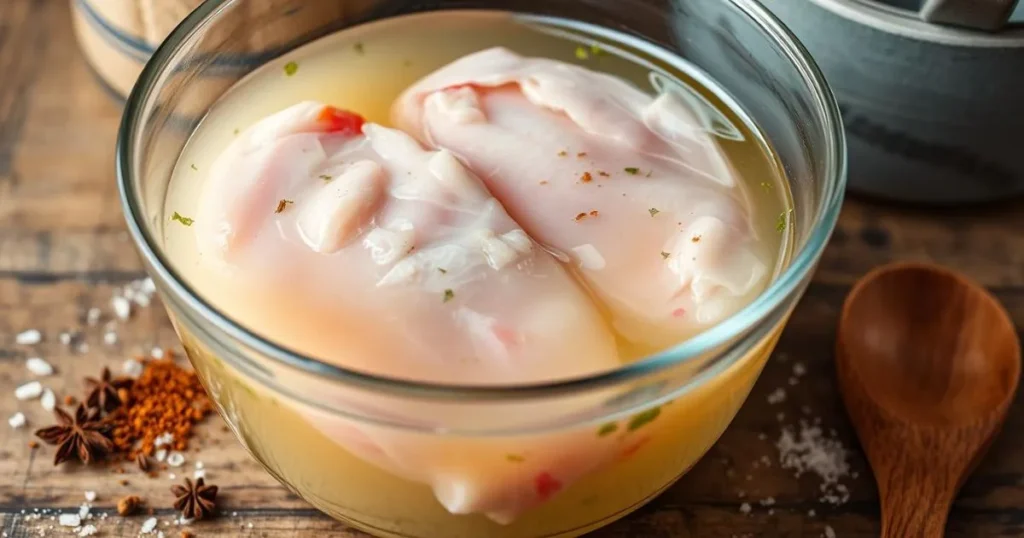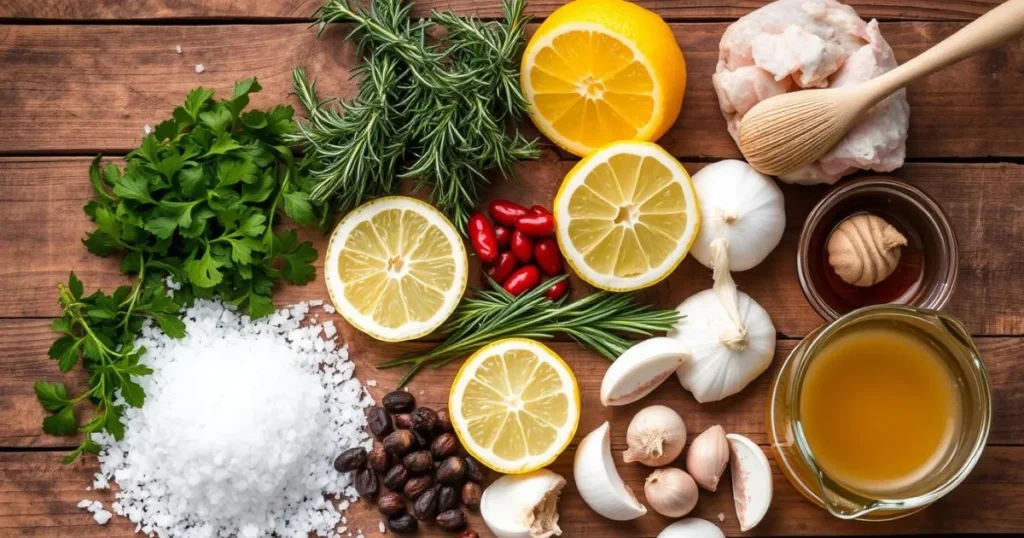Table of Contents
Brine Chicken Breast for Juicy Results
Getting juicy, flavorful chicken breasts can be tricky. But, the secret is in brining. Brining adds moisture and boosts the chicken’s natural taste. It’s a simple trick that makes your chicken dishes stand out, whether for a family meal or a dinner party.

Key Takeaways
- Brining chicken breasts helps them retain moisture and stay tender during cooking.
- The osmosis process and salt concentration play a crucial role in the brining method.
- Incorporating aromatics and seasonings into the brine solution can elevate the flavor profile.
- Following the proper brining time and temperature is essential for optimal results.
- Avoiding common brining mistakes can ensure your chicken breasts turn out perfectly every time.
Understanding the Science Behind Chicken Brining
Brining is a technique that makes chicken breasts moist and flavorful. But what happens when you soak chicken in a brine solution? Let’s explore the science behind brining.
The Osmosis Process and Moisture Retention
Osmosis is at the core of brining. When chicken is in a brine solution, water moves into the chicken. This makes the chicken moist and prevents it from drying out while cooking.
Salt Concentration and Its Effects
The salt in the brine is key. More salt means more water in the chicken, making it juicier. But, too much salt can make the chicken too salty.
The Role of Seasonings in Brine Solutions
Seasonings like herbs and spices add flavor to the brine. They make the brined meat taste better than just seasoned chicken. These flavors soak into the chicken during brining.
Learning about chicken brine recipe and moist chicken breast helps you brine meat perfectly. You’ll make juicy, flavorful chicken that will wow everyone.

Essential Ingredients for the Perfect Chicken Brine
Making a tasty chicken brine is key to juicy, tender chicken. Knowing the right ingredients is crucial. Let’s look at what makes a great chicken brine recipe.
The Salt Factor
Salt is the base of a good chicken brine. It helps the chicken keep moisture and soak up flavors. The right salt amount makes the chicken juicy and flavorful.
Sweetness for Balance
A bit of sugar or honey balances the brine’s saltiness. It adds a sweet touch that complements the savory flavors. This sweetness tenderizes the chicken and makes it more flavorful.
Aromatic Herbs and Spices
- Fresh herbs like rosemary, thyme, and sage add a nice aroma and flavor to the brine.
- Spices like black pepper, garlic, and bay leaves enhance the chicken’s natural taste.
Choosing and mixing these ingredients well makes a great chicken brine. It turns chicken breasts into a delicious dish. They become moist, tender, and full of flavor.
| Ingredient | Purpose |
|---|---|
| Salt | Enhances moisture retention and flavor absorption |
| Sugar or Honey | Balances the saltiness and tenderizes the chicken |
| Fresh Herbs | Adds aromatic complexity and depth of flavor |
| Spices | Contributes to the overall flavor profile of the brine |

“The secret to juicy, tender chicken lies in the perfect combination of ingredients within the brine. Master this technique, and you’ll elevate your chicken dishes to new heights of flavor.”
Step-by-Step Guide to Brine Chicken Breast
Brining chicken breast is a simple yet effective technique to ensure juicy, flavorful results every time. By following a few key steps, you can master the art of chicken brining and elevate your culinary skills. Let’s dive into the details.
Preparing Your Brine Solution
The foundation of a successful brine lies in the right balance of ingredients. Start by mixing together water, salt, and any desired seasonings or aromatics, such as peppercorns, herbs, or citrus zest. The optimal salt-to-water ratio is typically 1/4 cup of salt per 1 cup of water. Whisk the mixture until the salt has completely dissolved.
Proper Brining Time and Temperature
The duration and temperature of the brining process are crucial factors in achieving the perfect texture and flavor. Submerge your chicken breasts in the brine solution and refrigerate for at least 30 minutes, but no longer than 4 hours. The longer the chicken breasts brine, the more pronounced the flavor will be. Maintain a consistent temperature of around 40°F (4°C) to ensure food safety.
Post-Brining Treatment and Storage
After the brining process, remove the chicken breasts from the solution, rinse them under cold water, and pat them dry with paper towels. This step helps to remove any excess salt. You can then proceed to cook the chicken breasts using your preferred method, such as grilling, baking, or sautéing. For optimal storage, place the brined chicken breasts in an airtight container or resealable plastic bag and refrigerate for up to 3 days.
By following these straightforward steps, you’ll be on your way to creating juicy, flavorful chicken breasts that will impress your family and friends. Embrace the power of chicken brining techniques and elevate your chicken preparation methods for mouthwatering results.
| Ingredient | Amount |
|---|---|
| Water | 1 cup |
| Salt | 1/4 cup |
| Peppercorns (optional) | 1 teaspoon |
| Herbs (optional) | 1 tablespoon |
| Citrus zest (optional) | 1 tablespoon |
Common Brining Mistakes to Avoid
Brining your juicy chicken breasts can make a big difference. But, it’s important to avoid common mistakes. These mistakes can ruin your brining efforts. By avoiding them, you’ll get moist and flavorful chicken every time.
Overbrining
One common mistake is overbrining your chicken. While longer brining times can keep meat moist, too long can make it too salty. Watch the brining time closely and adjust it for the thickness of your juicy chicken breasts.
Improper Salt Concentration
The right salt-to-water ratio is key for good chicken marinade and brining meat. Too much salt makes the chicken taste bad, while too little doesn’t help. Check reliable recipes or ask experts for the best salt amount for your brining.
Inadequate Storage
After brining, it’s important to store the chicken right. Leaving it at room temperature or in warm places can cause bacteria to grow. Always refrigerate your brined chicken and eat it within the recommended time for safety and quality.
| Common Brining Mistakes | Solutions |
|---|---|
| Overbrining | Follow the recommended brining time based on the thickness of the juicy chicken breasts |
| Improper Salt Concentration | Use the right salt-to-water ratio for effective chicken marinade and brining meat |
| Inadequate Storage | Refrigerate brined chicken and consume within the recommended timeframe |
Avoiding these mistakes will help you make perfectly moist and tasty juicy chicken breasts. Learning to brine well will improve your chicken marinade and brining meat skills. Your family and friends will love it.
Conclusion
Brining your chicken breasts is a game-changer for tender, flavorful dishes. It’s all about understanding the science and following the right steps. This way, you get juicy, well-seasoned chicken that tastes amazing.
Brining is great for both seasoned cooks and beginners. It can make your meals much better. Try different brine solutions and seasonings to find what you like best.
The secret to great results is paying attention to detail and being open to trying new things. Trust your instincts and let the brine do its magic. Soon, you’ll be making brine chicken breast, tender chicken breast, and flavorful chicken dishes that everyone will love.
FAQ
What is the purpose of brining chicken breast?
Brining chicken breast makes it juicier and more flavorful. It lets the chicken soak up water and seasonings. This makes the chicken breasts tender and full of taste.
What are the key ingredients in a chicken brine solution?
A chicken brine needs salt, sugar, herbs, and spices. Salt pulls moisture into the chicken. Sugar and seasonings add flavor.
How long should you brine chicken breast?
Brine chicken breast for 30 minutes to 2 hours. This depends on how thick the chicken is. Don’t brine too long, or it will be too salty.
What are the common mistakes to avoid when brining chicken?
Don’t use too much salt or brine too long. Always keep the chicken cold during brining. Also, rinse and dry the chicken well after brining.
How does the brining process work to improve chicken breast texture and flavor?
Brining uses osmosis to add moisture and flavor to the chicken. The salt in the brine helps the chicken absorb these. This makes the chicken tender and tasty.
How should you store brined chicken before cooking?
Rinse the chicken well and pat it dry after brining. Store it in the fridge until you’re ready to cook. Keep it covered and use it within 1-2 days.

2 thoughts on “How to Brine Chicken Breast for Juicy Results”